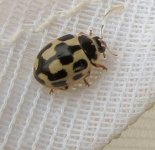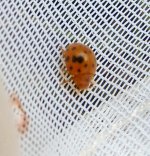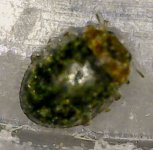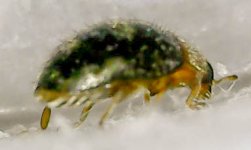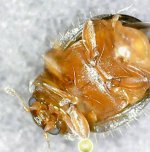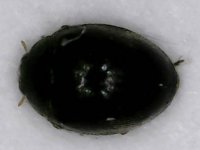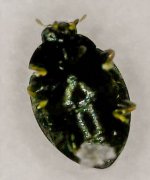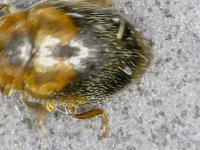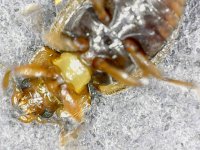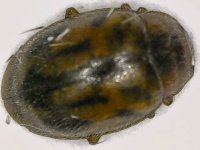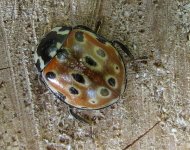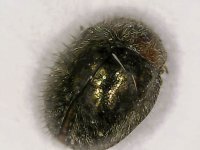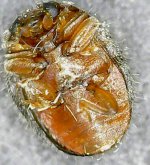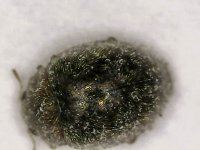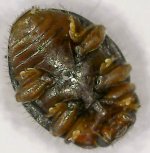-
Welcome to BirdForum, the internet's largest birding community with thousands of members from all over the world. The forums are dedicated to wild birds, birding, binoculars and equipment and all that goes with it.
Please register for an account to take part in the discussions in the forum, post your pictures in the gallery and more.
You are using an out of date browser. It may not display this or other websites correctly.
You should upgrade or use an alternative browser.
You should upgrade or use an alternative browser.
The Ladybird thread (6 Viewers)
- Thread starter Andy Bright
- Start date
More options
Who Replied?Maroon Jay
Airborne

I am a Ladybird Watcher or whatever it is called. I live in Canada. But so far have seen only four speices.
Larry Sweetland
Formerly 'Larry Wheatland'
Oh well 🤷. Shame really. I'm stuck on 19 species now (18 locally this year) and figured it would be good to get some birder-style gen on how to find some of the other onesIt seems not!
Larry Sweetland
Formerly 'Larry Wheatland'
Make that 20 🙂.
Found my first Pine Scymnus yesterday by visual search of the needles on a pine tree. At a parking area in the New Forest (Hawkshill enclosure), which funnily enough was the site where a Dark-eyed Junco was present for a little while several years ago.
Anyone else looking for ladybirds?
Found my first Pine Scymnus yesterday by visual search of the needles on a pine tree. At a parking area in the New Forest (Hawkshill enclosure), which funnily enough was the site where a Dark-eyed Junco was present for a little while several years ago.
Anyone else looking for ladybirds?
Surreybirder
Ken Noble
I'm slowly building up my garden list. I've had a couple of examples of Rhyzobius lophanthae (red-headed ladybird) beaten from Leylandii in our garden this week. Photos aren't exactly brilliant but it is a very small animal.
Attachments
Larry Sweetland
Formerly 'Larry Wheatland'
This is awesome Ken (and I've been following your posts in the ladybird FB group).
When I got into this earlier in the year I got really into finding them just by visual search, and was happy with my success rate, which included a few "inconspicuous" spp (Ryzobius litura, R. chrysomeloides, Pine Scymnus, and Spotted Marsh Ladybird). I then hit a wall, which I put down to the period when there are less adults about. But I've been very disappointed to find that there are still hardly any ladybirds to be found at all in the places I was finding shed loads early in the summer. It's literally dead round here. I think I might have to start other methods of locating them (beating etc).
When I got into this earlier in the year I got really into finding them just by visual search, and was happy with my success rate, which included a few "inconspicuous" spp (Ryzobius litura, R. chrysomeloides, Pine Scymnus, and Spotted Marsh Ladybird). I then hit a wall, which I put down to the period when there are less adults about. But I've been very disappointed to find that there are still hardly any ladybirds to be found at all in the places I was finding shed loads early in the summer. It's literally dead round here. I think I might have to start other methods of locating them (beating etc).
Surreybirder
Ken Noble
Larry, I think that the drought has seriously suppressed many insect numbers. I have struggled to find many aphids, for example. Normally our garden plants attract loads of blackfly, whitefly, green aphids etc. But there have been virtually none. So my guess is that a lot of ladybirds didn't survive. I don't know if you have had a drought in your area but that's my theory anyway.This is awesome Ken (and I've been following your posts in the ladybird FB group).
When I got into this earlier in the year I got really into finding them just by visual search, and was happy with my success rate, which included a few "inconspicuous" spp (Ryzobius litura, R. chrysomeloides, Pine Scymnus, and Spotted Marsh Ladybird). I then hit a wall, which I put down to the period when there are less adults about. But I've been very disappointed to find that there are still hardly any ladybirds to be found at all in the places I was finding shed loads early in the summer. It's literally dead round here. I think I might have to start other methods of locating them (beating etc).
I find Andrew Jewel's site very helpful. identification of inconspicuous ladybirds | uk | Ladybird1
He has a very helpful section on search methods. Personally, I balk at taking a sweep net and beating stick round the neighbourhood but I am happy to beat up our bushes and hedges! I notice that he finds a lot by putting cuttings into wheelie-bins and then watching the ladybirds climb out - a method I've not tried yet!!
Maroon Jay
Airborne

There is a ladybird Facebook group? I have been unable to find it. What is its full name? Can you send me a link, please?This is awesome Ken (and I've been following your posts in the ladybird FB group).
Surreybirder
Ken Noble
It's called Ladybirds of UK - so may not be much help to you, MJ.There is a ladybird Facebook group? I have been unable to find it. What is its full name? Can you send me a link, please?
Maroon Jay
Airborne

Thank you. I will look at it anyway. I found my 5th species recently. Seems like there are a lot more in other parts of the world than here in Canada.It's called Ladybirds of UK - so may not be much help to you, MJ
Surreybirder
Ken Noble
I don't know about Canada - but I guess that the prairies, with their very hard winters, may have fewer species than somewhere like BC?Thank you. I will look at it anyway. I found my 5th species recently. Seems like there are a lot more in other parts of the world than here in Canada.
pdwinter
Paul Winter
Also works well for hemiptera (true bugs), earwigs, and, in my garden, Southern Oak Bush-cricket - basically anything that sits on the rear-edge of vegetation.I notice that he finds a lot by putting cuttings into wheelie-bins and then watching the ladybirds climb out - a method I've not tried yet!!
Surreybirder
Ken Noble
Just to add a couple of recent sightings - all bashed from our garden hedge. They need confirming but I think the first is
Rhyzobius chrysomeloides (epaulet ladybird) and the second (Stethorus pusillus) dot ladybird (only about 1.5 mms long - black with yellow legs).
Rhyzobius chrysomeloides (epaulet ladybird) and the second (Stethorus pusillus) dot ladybird (only about 1.5 mms long - black with yellow legs).
Attachments
Larry Sweetland
Formerly 'Larry Wheatland'
Scored! Thanks to encouragement from Surreybirder I bashed some shrubs in a Bristol garden, and have just found my first Red-headed Rhyzobius (in cypress) and also 4 Round-keeled Rhyzobius (in privet) along with a (comparatively huge!) 14-spot
Last edited:
Surreybirder
Ken Noble
That's brilliant, Larry. I've been finding mainly red-headed recently (mostly in Leylandii) but also a Rhyzobius chrysomeloides in Lonicera this morning.Scored? Thanks to encouragement from Surreybirder I bashed some shrubs in a Bristol garden, and have just found my first Red-headed Rhyzobius (in cypress) and also 4 Round-keeled Rhyzobius (in privet) along with a (comparatively huge!) 14-spot
Attachments
Surreybirder
Ken Noble
Larry Sweetland
Formerly 'Larry Wheatland'
New species for me today in Ivy near my house in Bristol: 4-spotted Nephus (Ivy Ladybird). Out of range according to the field guide
Larry Sweetland
Formerly 'Larry Wheatland'
And another new one today, found in Ivy near my house in Bristol. A Red-flanked Scymnus (also outside of mapped range in the new field guide)
Surreybirder
Ken Noble
You're on a roll, Larry. Every inconspicuous ladybird I've put onto iRecord (five species so far) has come back with an 'out of range' warning. The usual thing: 'we are not saying that your record is incorrect but....'And another new one today, found in Ivy near my house in Bristol. A Red-flanked Scymnus (also outside of mapped range in the new field guide)
I don't know if you use iRecord but it is also very helpful in that it shows maps for every species and also you can see who else has reported the species (where and when). I'm intrigued by the number of sightings from graveyards - is that because they are islands of good habitat in otherwise degraded areas, I wonder. I'm still finding quite a few ladybirds in our hedge - at least three red-headed (Rhyzobius lophanthae) and an ivy (Nephus quadrimaculatus) yesterday. But the conspicuous ones are conspicuous by their scarcity. Just a few seven-spots plus the eyed in the last week.
The red-headed are quite variable in size and also in the amount of redness in the red areas. The two below are from 8th Oct.
Attachments
pdwinter
Paul Winter
iRecord uses the NBN Record Cleaner rules and the data in it can be quite out of date for both distribution and flight times (certainly for dragonflies which I know a bit more about)... Every inconspicuous ladybird I've put onto iRecord (five species so far) has come back with an 'out of range' warning. The usual thing: 'we are not saying that your record is incorrect but....'
Users who are viewing this thread
Total: 7 (members: 0, guests: 7)




